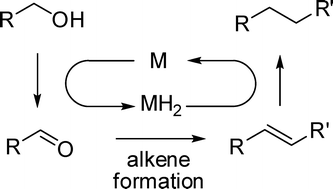Transition metal catalysed reactions of alcohols using borrowing hydrogen methodology
Abstract
The reactivity of alcohols can be enhanced by the temporary removal of

* Corresponding authors
a
Department of Chemistry, University of Bath, Claverton Down, Bath, UK
E-mail:
j.m.j.williams@bath.ac.uk
Fax: +44 1225 386231
Tel: +44 1225 383942
The reactivity of alcohols can be enhanced by the temporary removal of

 Please wait while we load your content...
Something went wrong. Try again?
Please wait while we load your content...
Something went wrong. Try again?
T. D. Nixon, M. K. Whittlesey and J. M. J. Williams, Dalton Trans., 2009, 753 DOI: 10.1039/B813383B
To request permission to reproduce material from this article, please go to the Copyright Clearance Center request page.
If you are an author contributing to an RSC publication, you do not need to request permission provided correct acknowledgement is given.
If you are the author of this article, you do not need to request permission to reproduce figures and diagrams provided correct acknowledgement is given. If you want to reproduce the whole article in a third-party publication (excluding your thesis/dissertation for which permission is not required) please go to the Copyright Clearance Center request page.
Read more about how to correctly acknowledge RSC content.
 Fetching data from CrossRef.
Fetching data from CrossRef.
This may take some time to load.
Loading related content
